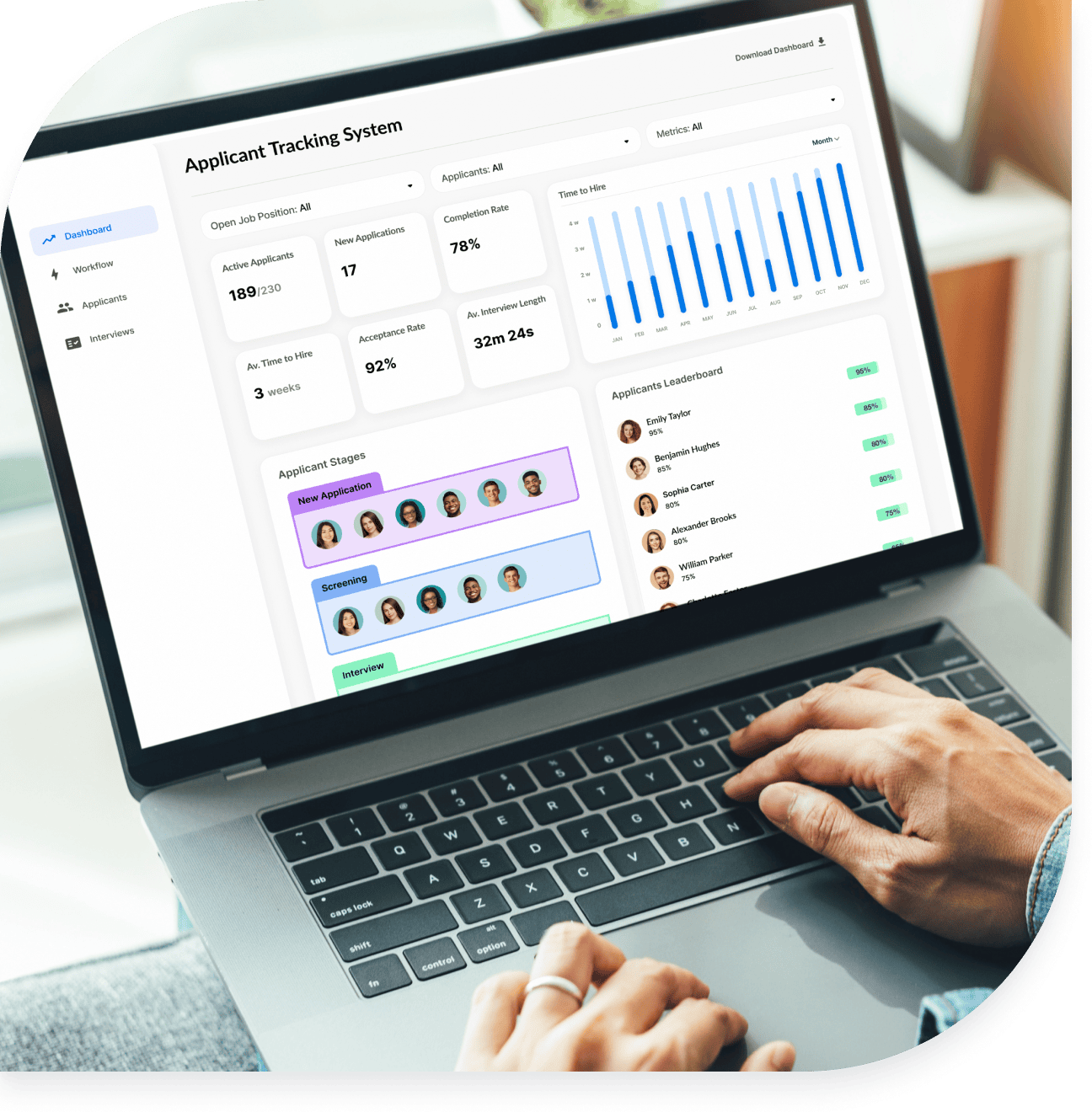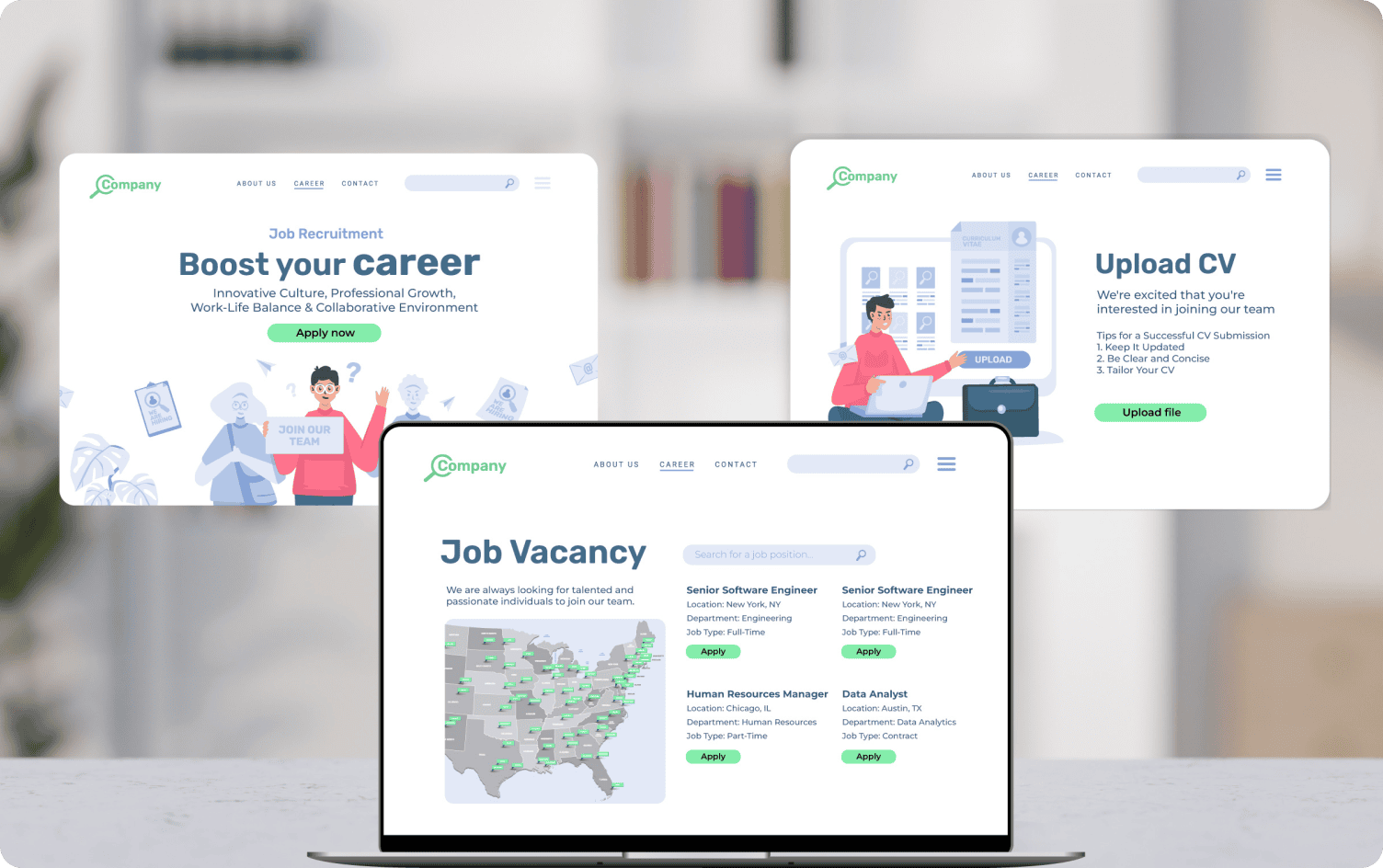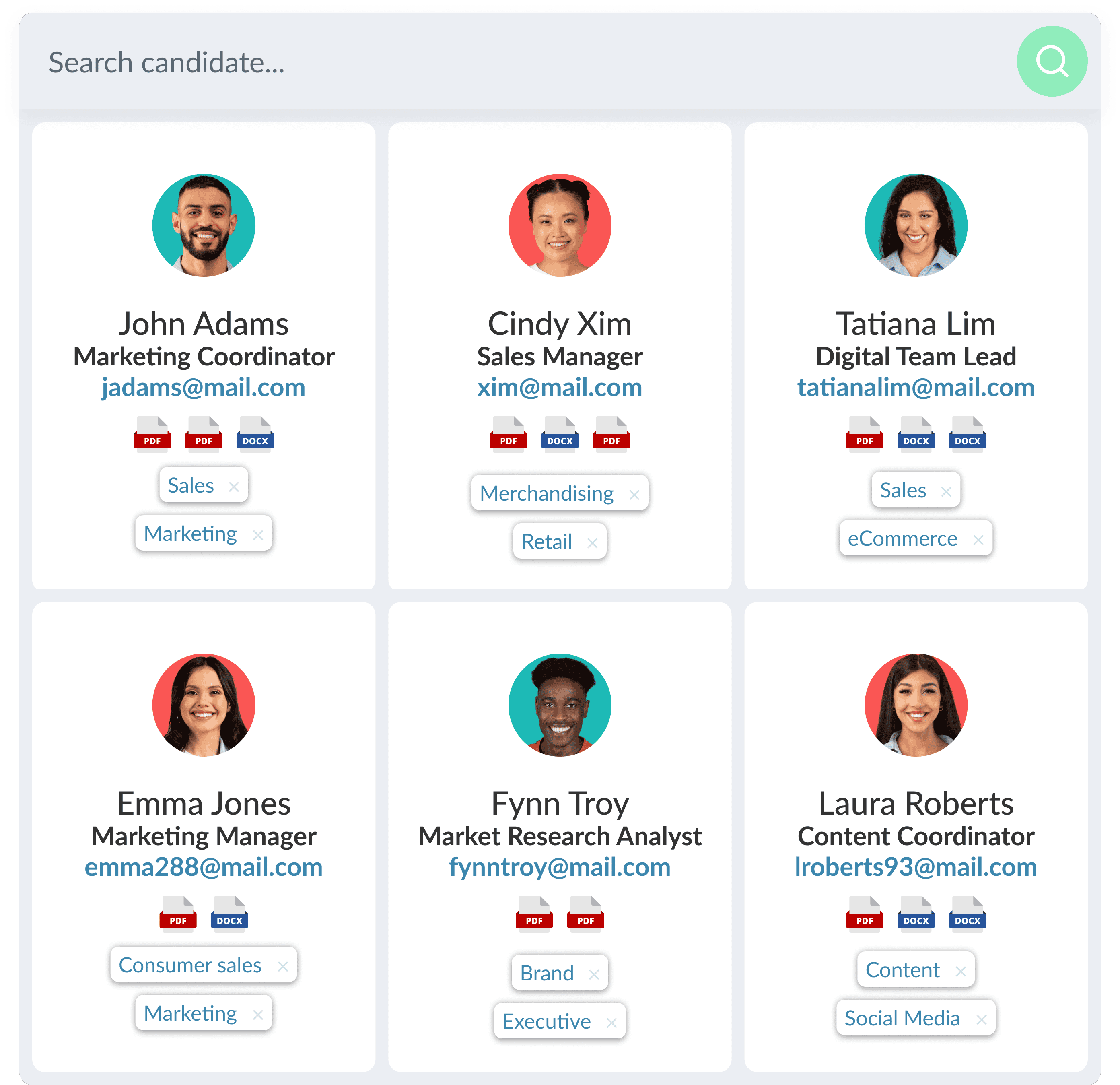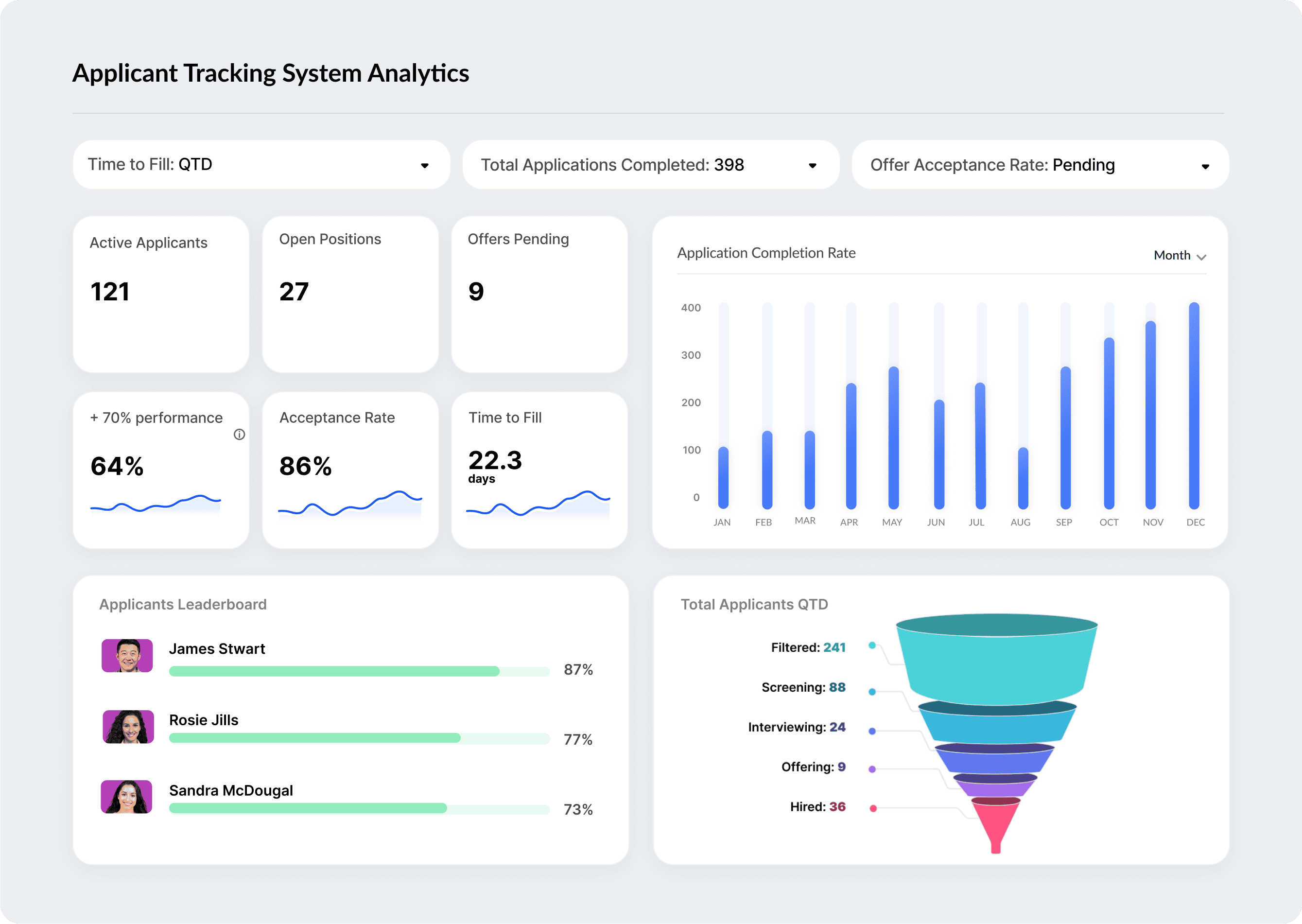
What Is Recruitment Automation?
Improve your hiring with automation. Streamline candidate screening, engagement, and analytics.

An Applicant Tracking System (ATS) is software that recruiters use to organize and streamline the hiring process. It manages job openings and applicant intake, providing a platform for recruitment automation to optimize for efficiency, track candidate progress, facilitate communication, and ensure compliance with hiring regulations.
"ATS" stands for Applicant Tracking System, meaning a type of recruiting technology that employers use to collect and store information about job applicants. As technology has advanced, the software now often includes features beyond simple data storage to provide a platform to automate candidate communications, coordinate and schedule interviews, curate candidate profiles, conduct reference checks, and so much more.
How do ATS platforms differ from HRIS? An ATS organizes all aspects of applicant data, while an HRIS platform manages employee data in a similar way. Learn more in ATS vs HRIS

There are numerous platforms available, each offering different features and functions. To best understand which features are most important for you, assess both your current and future hiring needs. Consider the following:
Do you have the right team for effective hiring?
Is your hiring process well-defined for easy ATS integration?
Have you thoroughly reviewed your current procedures?
Have you pinpointed your strengths and areas for improvement?
What specific features do you need in an ATS?
What other tools would you like to integrate?
How will a new ATS improve your hiring practices?
With a more defined understanding of your ideal process, now consider which features are most important to realize your vision.
Automating workflows: A recent SHRM report defines the average time-to-hire as 36 days. However, top talent stays on the market for far less, with reports suggesting it’s as little as 10 days. This means automation is crucial in saving time, as well as reducing the resources needed during recruitment. You can set-up automated workflows to perform a number of different recruiting tasks.
Here are some examples of workflow functions that may be automated:
Posting positions to a careers page and job boards with a single click
Progressing potential hires as a result of predefined test results
Reminding applicants that they have an upcoming interview
Asking unsuccessful candidates if they’d like to be contacted for future positions
Notifying your team when a job applicant has completed a task
Reminding managers to evaluate a completed interview
Applicant sourcing
Insights into which job boards/sources applications are coming from
Applicant management
An overview of where each potential hire is within a defined hiring journey
Candidate feedback
Survey results, which provide an overview of their experience with your organization while applying for a role
Time-to-hire reporting
How much time it takes to hire an individual, on average, and for each position
Hiring team reporting
The activities undertaken and the amount of time spent on each activity, on average, and as defined for each manager
Custom reporting
Data pulled from a custom range of information. For example, specific information defined by program objectives or skill sets
Job requisition workflows help to streamline the workforce planning process in an ATS, meaning the collaboration between managers and human resources. It also allows you to automate the approval process so that new roles move forward automatically once sign-off is received. As a centralized storage facility, applicant tracking systems can store predefined contracts and order forms as templates.
The top ATSs have the ability to build and host a careers page on the company website. Some allow careers pages to be customized with branding, tailored messaging, and videos to showcase the organization's brand. Some solutions can build custom career sites from scratch. These pages can include more complex features, such as visual maps showing candidates the exact location of all nearby positions.

Many organizations find it beneficial to integrate additional tools into their ATS, as this increases their capabilities and improves end results by ‘plugging in’ to tools for HRIS/payroll, skills testing, reference checking, etc. Integrations with other hiring tools can help streamline your recruitment workflow, consolidating visibility and control over the entire hiring process from a single platform.
Onboarding management can be an important feature, especially in environments like unionized workplaces and government organizations where consistent application of rules and procedures is paramount. An effective ATS streamlines the onboarding process by automating new hire tasks, including triggering the appropriate workflows and integrating with HRIS to create a new employee profile. This can include customizable workflows for specific roles or departments, organizing required training or assessments, managing crucial documents, and ensuring compliance with legal and organizational standards.
In a modern workplace, ATS are indispensable tools that help recruitment teams efficiently manage and fill open positions. They not only track job openings but also organize, coordinate, and guide applicant flow throughout the hiring process. ATS streamline collaboration among recruiters and hiring managers, improve organizational efficiency, and automate key processes to reduce the time-to-hire.


Applicant tracking systems are particularly beneficial for high-volume hiring, enabling organizations to manage hundreds or thousands of applications effectively. They support global hiring efforts and adapt to seasonal hiring peaks by automating communication and progression notifications. By implementing an ATS, organizations can scale their hiring processes and make more informed, efficient hiring decisions.
An ATS should simplify your hiring process by automating routine tasks, freeing up your team to concentrate on more important activities, like engaging with qualified candidates. On average, recruiters spend about 13 hours, or a third of their work week, sourcing candidates for a single job opening. An ATS significantly reduces this time. Here are some examples of how it can enhance specific stages of your hiring.
Pre-application
Job Posting: Automates posting new roles to job boards, ensuring wider reach and attracting more applicants.
Screening
Applicant Ranking: Organizes and filters potential hires, removing those who do not meet key criteria.
Engagement
Communication: Sends notifications to applicants and hiring teams, keeping everyone updated on the next steps.
Process management
Orchestration: Manages all stages of hiring, from job requisition to payroll/HRIS enrollment during onboarding.
The employer-candidate relationship has undergone a significant power shift during the past decade. The focus of candidate sourcing, and their management in the process, is now on how employers can provide a positive experience for all applicants. Candidate experience, a candidate's perception of their participation in your hiring process, is a key consideration when evaluating software options and setting up the process flow.
ATS with premium communication features can facilitate faster response times, increasing applicant engagement, and keeping top candidates moving forward in the process. ATS can also provide specific stage metrics that can help identify and reduce bottlenecks in the process. Within the platform, candidate perspectives can also be collected from automated surveys to get a full view of the hiring process.

The recruitment landscape is evolving rapidly, driven by technological advancements and changing job seeker behaviors. The explosion of AI enhanced technology is certainly one, but not the only consideration. Here are some defining features that will shape the future of ATS, ensuring they meet the dynamic needs of a modern workforce.
Many recent ATS developments focus on incorporating artificial intelligence (AI) to enhance functionality. AI recruiting features include resume parsing, candidate matching, and predictive analytics, which can speed up the hiring process. However, it's vital to balance technological advancement with responsible use. This means being able to address the AI risks associated with regulatory and ethical concerns. Ensuring transparency, fairness, and compliance with evolving AI regulations is crucial to maintaining ethical hiring practices. A durable ATS, built for the future, should balance current AI expectations with a responsibility for what is coming in the near future.
Candidates currently prioritize mobile accessibility, looking to search and apply for jobs easily on mobile devices. ATS should adapt in real time to accommodate different generational expectations and technological advancements, ensuring a frictionless candidate experience.
ATS will increasingly need to integrate and operate with other platforms and digital entities. These include external job boards, internal systems like HRIS and enterprise software, and even social media platforms for marketing open jobs and attracting candidates.Automated The ability to integrate with all of these systems will certainly define an ATS’s measure of relevance in the future.
An ATS, supported by clear internal policies, can leverage analytics and automated workflows to minimize the impacts of hiring bias on recruiting. This is an important part of advancing Diversity, Equity, and Inclusion within an organization. Similarly, it can pinpoint barriers that limit accessibility for certain groups. As social expectations evolve, future demands on human resources departments will extend beyond simply meeting ethical standards to ensuring an equitable hiring experience for candidates and employers alike.
Recently, hybrid work environments are becoming the norm. To stay efficient in this asynchronous setting, organizations need a robust ATS to coordinate decision-making, manage hiring, and communicate with candidates. These key benefits highlight the role of an ATS in a hybrid workplace.
Automated communication: Employers can send SMS and email reminders for interviews or post-interview 'thank you' notes, ensuring consistent communication with candidates from anywhere.
“An applicant tracking system is necessary for recruiting teams to stay organized in hybrid work environments. With some members in the office and others at home, recruiting teams face the challenge of collaborating effectively. The right ATS can help recruiting teams on track, with the outcome of providing a positive candidate experience.”

Phil Strazzulla
Founder, SelectSoftware ReviewsMost organizations now use an online applicant tracking system as opposed to an on-premise system where the ATS is hosted in an internal network. For global talent acquisition strategies, using an online ATS means organizations can efficiently manage recruitment at the local level while maintaining company-wide standards and policies worldwide. This brings up the idea of evaluating the ATS’ data security features.
When considering a cloud-based ATS be sure to fully vet each vendor’s encryption and cybersecurity measures. Cloud-based providers should be able to demonstrate their security competencies like showing credentials or accreditation for industry-leading security standards (GDPR, PIPEDA, CCPA, VPAT), certifications (SOC2, ISO), and data encryption, in transit and at rest.

Applicant tracking systems are one of the most popular tools for talent acquisition teams, meaning that most Fortune 500 companies use them. Many small to mid-sized companies also use ATS to reduce time spent on administrative tasks and to ensure hiring resources are optimized.
Below, we explore how different types of ATS can help many organizations, from start-ups to healthcare organizations.
Start-ups
Applicant tracking systems can help start-ups manage their process and decrease their time-to-hire with fewer resources. Automating recruiting tasks such as pre-screening allows smaller HR departments to rapidly increase their volume of hiring.
Enterprise
With scalability and growth top of mind, an ATS can handle high-volume recruitment scenarios and pre-screen hundreds and thousands of applicants. They also strengthen collaboration between recruiting teams globally and within hybrid work environments by providing a single tool for all recruitment activities.
Government
An applicant tracking system helps to standardize and digitize the hiring process. Government agencies can standardize the job requisition process and keep detailed records of activities throughout the hiring process for internal compliance and auditing purposes.
Staffing
For recruiting and staffing firms, applicant tracking systems streamline recruitment processes for optimal hiring results. Recruiters can spend time with their qualified candidates rather than completing administrative tasks. Many applicant tracking systems integrate with other hiring tools, which offers flexibility in meeting a range of individual client needs.
Healthcare
An ATS can help keep hiring on track within a busy environment with automated workflows. Workflows can also send reminders to hiring managers to ensure they complete ratings. Platform branding and the ability to highlight the unique qualities of the healthcare facility help to attract and retain top talent.
Hospitality
Applicant tracking systems support high-volume recruiting by pre-screening thousands of applicants and can reduce time-to-hire by automating recruiting tasks. They also help minimize drop-off rates by increasing candidate engagement through automated reminders and communications.
Education
By automating recruiting tasks, applicant tracking systems can speed up the hiring process. As a result, they help K-12 school districts outpace the competition in making an offer to top talent. For admissions, an ATS helps save time when screening a high volume of applicants and makes it easier to identify top applicants.
An ATS is a type of software used by recruiters and employers to collect, sort, scan, and rank job applications for open positions. It will scan an applicant's employment history, education and hone in on specific job requirements like knowledge, skills and abilities. To make sure your resume is optimized for an ATS, review our guide on building an ATS-friendly resume.
An ATS improves the hiring process by streamlining tasks such as resume screening, interview scheduling, and candidate communication. This automation saves time, reduces administrative burden, and enhances the overall efficiency and effectiveness of recruitment efforts.
Not all ATS use AI. While many modern ATS platforms incorporate AI features such as resume parsing, candidate matching, and predictive analytics, some systems rely on more straightforward automation and filtering techniques without controversial AI capabilities.
Modernize your hiring process with expert insights and advice.

Recruitment Essentials:
Versatile Video Interviews
Unlock the potential of recruitment automation with VidCruiter's comprehensive interviewing solutions. Our platform offers:
Join thousands of organizations transforming their hiring process. Learn more and book a demo.